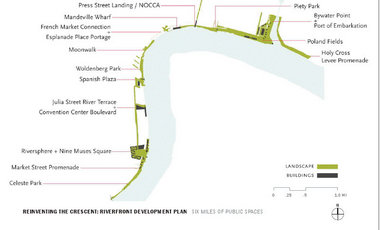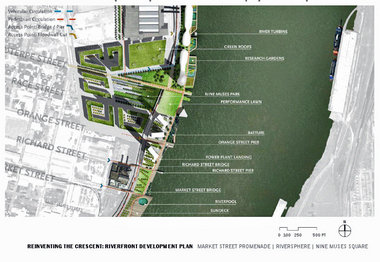
Architect Alan Eskew is helping to make the New Orleans riverfront more accessible to New Orleanians.
Hear Alan Eskew interviewed on Sharon Litwin’s weekly program, Notes from New Orleans, on WWNO radio. Click here to listen.
In all the years I have lived in this Crescent City, I’ve always wondered why we east bank folk have never really been able to take advantage of our closeness to one of the magnificent rivers of the world. Prior to the opening of the Aquarium 20 or so years ago, with the adjoining Woldenberg Park, the most I ever saw of the Mississippi was from the passenger seat of a car, if someone else was driving across the bridge to the West Bank or, occasionally, from the windows of one or two restaurants. The closest I could come to the actual riverfront was from the Moonwalk at the foot of Jackson Square.
So it’s nice to know that after more than a year of planning, architect Alan Eskew and his colleagues at EskewDumezRipple are six months into phase one of a major initiative designed to re-connect a whole lot more of New Orleans to the Mississippi River.
Reinventing the Crescent is a development plan that, when completed, will return six miles of riverfront to the citizens of this city, allowing them and the thousands of tourists who come here an opportunity to walk along the banks of one of the most famous rivers in the world, from Jackson Avenue all the way down to Bywater.
Historically cut off from the river by wharves and warehouses that served a once-bustling port, New Orleanians have had few public waterfront spaces available to them. But with the slowing of maritime activity and the consolidation of the once-sprawling Port of New Orleans into a smaller and more secure footprint, there has come the opportunity for change. And with a cooperative agreement signed by the city and the port, what once was just a dream is becoming a reality.
And that’s why architect Alan Eskew is so excited. For almost 30 years, he has been a major player in a number of waterfront development projects in New Orleans. A Louisiana native with an undergraduate degree from Louisiana State University and a master’s degree from the University of California Berkeley, one of Eskew’s earliest projects was the waterfront design of the 1984 World’s Fair. After that he was the leader of a multidisciplinary design team for Phase I and Phase II of the Aquarium of the Americas and Woldenberg Park.
 So it seems quite natural for Eskew to continue his dream of opening up more of the Mississippi riverfront. But he knows that, to get the public’s buy in, it takes more than simply presenting architectural designs on paper. It’s the way by which such ideas are explained and by demonstrating how his team’s dream will translate into reality that he will be able to make his plans become generally acceptable.
So it seems quite natural for Eskew to continue his dream of opening up more of the Mississippi riverfront. But he knows that, to get the public’s buy in, it takes more than simply presenting architectural designs on paper. It’s the way by which such ideas are explained and by demonstrating how his team’s dream will translate into reality that he will be able to make his plans become generally acceptable.
“One of the real challenges of doing urban development on an urban waterfront is how to balance all the competing interests for that piece of real estate,” Eskew says. And that, he explains, means public hearings, overcoming hostilities, and working with neighborhood groups. So within his team there have been numerous thoughtful internal discussions about what is the best way to communicate such a vision to the community at large, especially to those who often are skeptical about city-driven projects.
 For the most part, Eskew says, the design aspect has met with approval. Still to come are some tough decisions about how the urban waterfront areas will be maintained and which entities will be in charge.
For the most part, Eskew says, the design aspect has met with approval. Still to come are some tough decisions about how the urban waterfront areas will be maintained and which entities will be in charge.
But for right now, let’s start thinking about picnics by the river, jogging along the banks, or walking the dog to the sound and sight of the riverboats, because Reinventing the Crescent is truly under way. Just think, by about this time next year New Orleans will have a new 20-acre park along a 1.5 linear mile stretch of riverfront from the foot of Elysian Fields almost to Poland Avenue.
I can’t wait! To see what is planned, click here.
 NOLAbeings Multimedia artist Claire Bangser created NOLAbeings as a portrait-based story project that marries...
NOLAbeings Multimedia artist Claire Bangser created NOLAbeings as a portrait-based story project that marries...  Voodoo in New Orleans: Reviving history: New Orleans fortune telling This article takes a deep dive into the history of Voodoo in New Orleans, its hybridization with Catholicism, and its present-day place in the city's culture. The author visits fortune-tellers in the French Quarter, using their guidance as a tool for introspection rather than a deterministic predictor of the future. Through her experiences in New Orleans, the author feels a mystical connection to both the past and the future.
Voodoo in New Orleans: Reviving history: New Orleans fortune telling This article takes a deep dive into the history of Voodoo in New Orleans, its hybridization with Catholicism, and its present-day place in the city's culture. The author visits fortune-tellers in the French Quarter, using their guidance as a tool for introspection rather than a deterministic predictor of the future. Through her experiences in New Orleans, the author feels a mystical connection to both the past and the future. 